June 23, 2008
Heartworms in Dogs: Understanding the Threat
A heartworm infestation is one of the most dreaded diseases in dogs. As their name suggests, heartworms infect the heart and can stay there until they die. However, they sometimes end up in other parts of the body such as the brain, eyes, and legs. But it is in the heart that they hurt a dog the most.

Heartworm transmission
How do these parasites get inside your dogs? It all starts when a mosquito bites a dog that already has heartworms and feeds on blood that has heartworm larvae. Then that same mosquito bites another dog and transfers the larvae to it. These larvae are released into the bloodstream, and since all blood has to pass through the heart, the heartworm larvae reaches the heart and stays there until it matures. After 4 to 6 months, these adult heartworms make their presence felt and they may start to affect the health of the dog.
Symptoms of heartworm infestation
Heartworms in dogs can be fatal because they can cause a blockage either in a valve of the heart or in one of the blood vessels. Aside from this, the dog’s immune system also weakens and other symptoms start to show such as lung infections, continuous coughing, loss of appetite, and lack of energy.
Prevention is still king
Although a vet can treat a dog with heartworm infestation, the treatment can be dangerous because there is no guarantee that every dog can survive it. Therefore, preventing your dog from getting any heartworms is still the best course of action.
One way you can do this is to make sure that your dog regularly visits the vet to be checked for any heartworms or other parasites. The vet can recommend or prescribe an oral or topical drug that are applied once a month to keep these worms away from the heart.
Do you know of any other ways to prevent your dog from getting infected with heartworms? Comment on this article to share your knowledge to other dog owners.
Heartworm Treatment And Prevention for Dogs

If you think heartworms are just microscopic creatures that present little or no harm at all to your dog, think again. A dog with heartworm disease has 6-12-inch worms infesting its heart. These worms will eventually mature and move from the heart to the other organs as well, since the heart pumps blood to the entire body.
Heartworm disease is not to be taken lightly.
No dog, or any animal for that matter, should be made to suffer such a pest as heartworms. This article will present some tips on prevention and heartworm treatment for dogs so that you can help your pet live a long, healthy life.
Tip #1: Don�t Be Ignorant
More and more dogs are becoming heartworm positive each month - mostly due to misinformed owners. If you really care for your pet, take the time and effort to be in the know about heartworm disease and other dangerous pet diseases.
Tip #2: Prevention Is Better Than Cure
A heartworm-infested pet will not exhibit any recognizable symptoms until it is in its advanced stages in which the heartworm larvae begin to mature; by that time, symptoms might get worse enough and eventually lead to heart failure. DO NOT WAIT FOR SYMPTOMS. There are different types of medication available for the prevention of heartworms in dogs. Make it a habit to give your dog heartworm preventive medicine such as Heartgard or Revolution once a month and give yourself some peace of mind. Also, consult your vet at least once a year to have your dog tested for heartworms.
Tip #3: Know How Sick Your Dog Is
 If you suspect your dog to be a victim of heartworms, consult your vet immediately. Dogs with heartworm disease are classified under 4 categories according to risk:
If you suspect your dog to be a victim of heartworms, consult your vet immediately. Dogs with heartworm disease are classified under 4 categories according to risk:
-
Class I: Lowest risk
-
Class II: Moderately Affected
-
Class III: Severely Affected
-
Class IV: Caval Syndrome
Before undergoing heartworm treatment, dogs must be classified under the correct category by your vet. This will determine the type of treatment to be administered. Heartworm disease requires professional and careful medical attention and complete rest at home for your pet afterwards. After treatment, the heartworms in your dog will be dead or dying. There will still be some left in its heart but these will be gradually broken down into smaller pieces until they are small enough to be eliminated by the body. While this process takes place, your dog needs complete rest for at least 5 weeks.
I hope that this article has somewhat informed you of the perils of heartworms in dogs. Never take them for granted; never leave your dog�s health to chance. You’d rather be playing with your pet than nursing them, wouldn’t you?
June 19, 2008
The Pet Lover Chronicles: Be Kind To Your Dog’s Heart

Once in a while, our pet dog gets sick or has health problems; fleas, ticks, minor infections, you name it. However, here�s one disease we all hope our dogs never have to go through in their lifetime - heartworms.
Given the dangers that heartworms pose, we try so hard to fight these parasites with everything we�ve got. However, we sometimes forget the risks involved in doing so. Nobody wants heartworms, but nobody wants a sick dog from all the side effects of heartworm medication, too. That�s why we should take note of the risks that some heartworm preventative medications bring. Yes, even heartworm medication has its disadvantages and health risks; and it is very important for all dog lovers to know about them.
Always ask your Vet
DO NOT JUST USE HEARTWORM PREVENTATIVE MEDICATION WITHOUT CONSULTING YOUR VET FIRST. This is because using the wrong preventative will result in complications. Below are some of the most common heartworm preventative medications for dogs and the risks involved in improper dosages and administration:

Heartgard contains ivermectin, and wrong dosages of this may cause depression, unsteady gait, dilated pupils, vomiting, drooling, tremors, coma, depression and, occasionally, death.

2. Revolution
Revolution is good for heartworm and flea control. However, it contains a parasiticide called selamectin which in wrong dosages may cause depression, unsteady gait, dilated pupils, vomiting, drooling, tremors, coma, and, in some cases, even death.
 These risks are a threat to our dogs as the heartworm itself, so we should be prudent in giving heartworm preventative medications. For me, a regular consultation with my vet is still the best way to determine the best method of heartworm prevention for my dog and a surefire way of ensuring that I�m being kind to its heart.
These risks are a threat to our dogs as the heartworm itself, so we should be prudent in giving heartworm preventative medications. For me, a regular consultation with my vet is still the best way to determine the best method of heartworm prevention for my dog and a surefire way of ensuring that I�m being kind to its heart.
How about you - have you been kind to your dog’s heart?
Worm Is Where The Heart Is: A Brief History of Heartworms
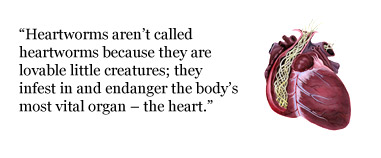
The first ever documented case of heartworm disease in dogs was published in an issue of The Western Journal of Medicine and Surgery in the United States in 1847 - more than a hundred years ago. Today, the heartworm, as dangerous as the first time it appeared, still poses a threat to our dogs.
What are heartworms?
The heartworm is a type of filaria, a small thread-like worm - they are parasitic roundworms that spread from host to host through the help of mosquitoes. When mosquitoes that carry heartworm larvae bite an animal, they also transmit the larvae. These larvae then mature, lodge in the dog�s heart and other organs. Dogs are the most common heartworm hosts but heartworms can also affect other animals, even humans.
Heartworms are very dangerous for both the pets and their owners. Heartworm disease can result in serious complications that include congestive heart failure and even death, if not treated immediately. The no. 1 defense against heartworms is the use of monthly preventative medication. By doing so, we can stop them even before they mature and have a chance to cause complications.
How can we stop heartworms?
 Heartworms aren�t called heartworms because they are lovable little creatures; they infest in and endanger the body�s most vital organ - the heart. So, it is only right to treat them with utmost urgency when it comes to protecting our pet�s health. Unfortunately, there are no clinical signs to watch out for at the onset of heartworm infestation; the symptoms and complications come in its later stages, and by then it might be too late. Our best bet is to prevent these parasites from ever making a host out of our canine friend. Below are 2 of the best options to consider when looking for heartworm preventative medication:
Heartworms aren�t called heartworms because they are lovable little creatures; they infest in and endanger the body�s most vital organ - the heart. So, it is only right to treat them with utmost urgency when it comes to protecting our pet�s health. Unfortunately, there are no clinical signs to watch out for at the onset of heartworm infestation; the symptoms and complications come in its later stages, and by then it might be too late. Our best bet is to prevent these parasites from ever making a host out of our canine friend. Below are 2 of the best options to consider when looking for heartworm preventative medication:
- Heartgard or its generic alternative Nuheart
- Revolution
Both of these preventative medicines contain ivermectin which is used in a wide range of animals including cattle, horses, pigs, birds, and of course, cats and dogs. Ivermectin is very effective in killing heartworm larvae which are very sensitive to this chemical. In dogs, very low doses are sufficient for it to be effective.
Revolution is good for heartworm and flea control. It contains a parasiticide called selamectin which is effective against heartworm larvae, fleas, ear mites, sarcoptic mites and the American Dog Tick.
Before using any of these, make sure that you consult your vet because using the wrong medication can cause more harm than good. When it comes to your dog’s health, it’s better to be safe than sorry, right?
Before using any of these, make sure that you consult your vet because using the wrong medication can cause more harm than good. When it comes to your dog’s health, it’s better to be safe than sorry, right?
June 13, 2008
Understanding Heartworm Infection
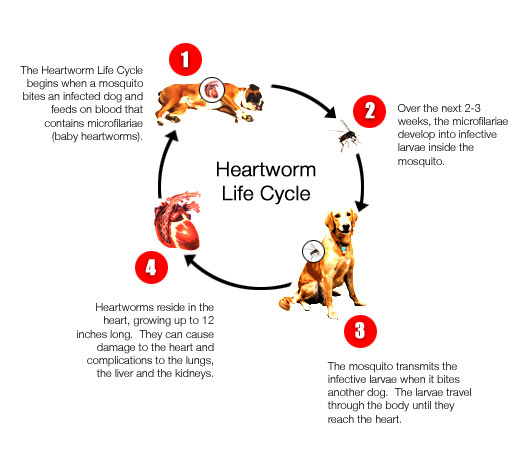
Do you know that heartworms, also known as Dirofilaria immitis, can spread from one dog to another?
Well… Actually, heartworms do not get transmitted directly from one dog to another. This means that heartworm disease is not contagious. It is transmitted by a mosquito. When a mosquito bites a heartworm-infected dog, it feeds on blood that contains microfilariae (microscopic, immature offsprings of heartworms) and it becomes a carrier of the infection.
It takes 10 to 14 days for the microfilariae to develop into infective larvae inside the mosquito. After that, when the infected mosquito bites another dog, these infective larvae are transmitted through the bite wound and cause an infection.
Once in the dog’s body, the infective larvae will travel throughout the body until they reach the heart, where they will reside and mature into adults. It takes approximately a little over 6 months for the infective larvae to become adult worms. Some adults can grow as much as 14 inches long. It is also at this stage when they start to produce microfilariae, which will circulate in the bloodstream. When an uninfected mosquito bites this dog, it picks up the microfilariae and the cycle of infection starts again.
Heartworms can live in a dog for 5 to 7 years and aside from causing damage to the heart, they also cause dysfunction and complications to the lungs, the liver, and the kidneys.
In canine heartworm infection, it is important to note that the development of adult heartworms takes 6 to 7 months (184 to 210 days). Also, its only natural agent for transmission is the mosquito, so it is only logical that heartworm infection is more prevalent in areas where mosquitoes abound.
Now that you know how heartworm disease is transmitted, you can help protect your dog by getting rid of those pesky mosquitoes that carry the infection. Why don’t you start by cleaning your homes to keep mosquitoes away?
June 12, 2008
Pet Enemy Files: The Heartworm Life Cycle and Transmission
If you think that fleas are all you have to worry about, think again. Believe it or not, as nasty as fleas are, they are not as foul and disgusting as heartworms.
Heartworms are nasty because they are a sneaky bunch. These parasites make their way inside your pet and live there without you knowing it. While inside your pet, they grow and multiply nonstop and cause heart failure and serious damage to other organs.
Heartworms, or Dirofilaria immitis, are creepy, serpent-like monsters that are close relatives of roundworms. They usually affect dogs, but they may also infest cats, ferrets, sea lions, and in some cases, even humans. Heartworms are transmitted from one animal to another through mosquitoes.
How It All Begins
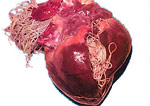
An animal that is infested with heartworms may contain hundreds to thousands of baby heartworms called microfilariae in its bloodstream. These microfilariae are microscopic and can live inside an animal for up to three years. However, not all these baby heartworms get to develop into adults. This is because the microfilariae need to be ingested by mosquitoes for them to develop into larvae; otherwise they remain in the animal’s bloodstream and eventually die. In other words, mosquitoes play a major part in the heartworm life cycle.
Inside the Mosquito
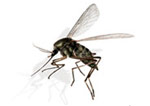 Microfilariae are ingested by mosquitoes when they feed on the blood of an infected animal. Once ingested, these first-stage larvae (L1) or baby heartworms make their way into the mosquito’s stomach then to its kidney. There, they molt and change into second-stage larvae (L2). In a few days, they start to develop their internal organs, increase in length and become third-stage larvae (L3) or miniature adult heartworms. This is called the infective stage, wherein they leave the mosquito’s kidney and travel to its proboscis or mouth where the third-stage larvae become ready for transmission. In this entire process, the mosquito serves as a temporary host for the heartworm larvae.
Microfilariae are ingested by mosquitoes when they feed on the blood of an infected animal. Once ingested, these first-stage larvae (L1) or baby heartworms make their way into the mosquito’s stomach then to its kidney. There, they molt and change into second-stage larvae (L2). In a few days, they start to develop their internal organs, increase in length and become third-stage larvae (L3) or miniature adult heartworms. This is called the infective stage, wherein they leave the mosquito’s kidney and travel to its proboscis or mouth where the third-stage larvae become ready for transmission. In this entire process, the mosquito serves as a temporary host for the heartworm larvae.
Into Another Animal
 The heartworm larvae find their way into a new host when the mosquito carrying them bites another animal. When the mosquito bites the new host, the heartworm larvae are deposited into the animal’s skin, where they stay for several days. Then, they burrow deeper into the animal and settle in its tissues where they linger for a couple of months. While inside the animal’s tissues, they continue to develop until they become fourth-stage larvae (L4) or young adult heartworms.
The heartworm larvae find their way into a new host when the mosquito carrying them bites another animal. When the mosquito bites the new host, the heartworm larvae are deposited into the animal’s skin, where they stay for several days. Then, they burrow deeper into the animal and settle in its tissues where they linger for a couple of months. While inside the animal’s tissues, they continue to develop until they become fourth-stage larvae (L4) or young adult heartworms.
Once they become young adults, they leave the tissues and enter the animal’s bloodstream. They circulate in the bloodstream and eventually end up in the heart. There, they continue to grow until they become full-fledged heartworms. Inside the animal’s heart, they mate to produce microfilariae. Then, the cycle starts all over again.
What to Do
 The heartworm life cycle takes about six months, or an equivalent of a normal winter. This is why most veterinarians prefer testing your pet for heartworms before spring. As with fleas, transmission of these parasites is more common during warm months when mosquitoes are active, which is usually from late spring to early fall. Heartworms are also prevalent in places where the weather is warm. In the United States, heartworms are fairly common in southeastern and midwestern areas.
The heartworm life cycle takes about six months, or an equivalent of a normal winter. This is why most veterinarians prefer testing your pet for heartworms before spring. As with fleas, transmission of these parasites is more common during warm months when mosquitoes are active, which is usually from late spring to early fall. Heartworms are also prevalent in places where the weather is warm. In the United States, heartworms are fairly common in southeastern and midwestern areas.
However, even if you don’t live in places where there is warm weather, it doesn’t mean that your pet is no longer susceptible to heartworms. Dogs are especially more susceptible regardless of age, size and breed. For this reason, it’s important to keep your dog on heartworm preventatives all year ’round. Getting them regularly tested for heartworms also helps in making sure that none of these parasites sneak their way inside your pet. You don’t want heartworms to pull a fast one on you, do you?
Diagnostic Tests: Tools for the Prevention and Treatment of Heartworm Disease in Cats
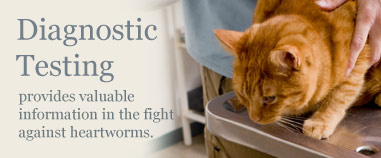
Heartworm disease should be taken seriously. This is especially true for cats since they are not natural hosts for these worms so when they get infected the symptoms are unpredictable and confusing. Likewise, these worms do not only invade the cat’s heart but also other areas like body cavities, arteries, the brain and the spinal cord. The bad news is that there are currently no satisfactory heartworm treatments for cats. This is because the medications that kill heartworms may prove dangerous to them because the cat’s body does not react well to dead heartworms.
But all hope is not lost for these felines and cat owners need not wait for their cats to show any symptoms. There are now diagnostic tests available that may help determine if the cat has heartworm disease so it can be dealt with immediately .
Thoracic Radiography or X-rays.
This test will show if the cat’s main pulmonary artery is enlarged, or weakened and twisted. This condition is caused by larvae in the fifth stage level (L5). Vets use this test to confirm a diagnosis and to develop a prognosis.
Echocardiography or ultrasound readings of the heart
This is a test that uses sound readings to visualize areas inside the body. It can show if heartworms are in the heart, the main pulmonary artery or in any of its immediate branches. Although this test has its limitations - like not getting readings from the branches of the pulmonary arteries where young worms are found in cats - it can confirm the presence of heartworms in the body.
CBC or complete blood count
This can detect if there is heartworm infection when the cat exhibits anemia, nucleated erythrocytes (immature red blood cells), eosinophilia (increased number of eosinophils, a type of white blood cell) and basophilia (increased number of basophils, a type of white blood cell). With this test, the strongest indicator of heartworm disease is the presence of a large number of basophils.
Serologic testing
This can determine the presence of larvae in the fifth stage level (L5) and adult worms, both of which cause heartworm disease in cats. The combined use of antibody and antigen tests are effective methods that can help both veterinarians and pet owners determine the appropriate preventive steps to take.
1. Antigen Tests
These tests can indicate an infection by detecting particular antigens that are present in adult female heartworms that are at least seven or eight months old. Most tests of this kind are used for dogs but there are several that are approved for cats and are available in clinics. These tests may not be able to detect the presence of a majority of heartworms (Immature and male worms) but they are reliable when it comes to determining the presence of female heartworms.
2. Antibody Tests
These tests detect antibodies produced by the cat in response to the presence of heartworm larvae. They could detect infections as early as 8 weeks after a mosquito has transferred the larvae into the cat’s body. Test results can be improved through the use of genetically engineered heartworm antigen.
Inspite of their limitations, diagnostic testing for heartworms for cats is "good medical practice" as recommended by the American Heartworm Society (AHS). These tests not only alert us of the presence of heartworms but they also tell us when to begin taking preventive measures to stop the increase in the number of heartworms and to control the symptoms. There are many ways to protect our cats and one of the most effective means against these parasites is to use these FDA-approved heartworm preventive products for cats like Interceptor� (Milbemycin oxime, orally) and Revolution� (Selemectin, topically).
Now, which test are you going to use on your cat?
Side Effects of Heartworm Treatment in Dogs

Heartworm disease should not be ignored because it can be fatal. Dogs need not experience this disease because it can be avoided through preventative medications, proper diet and hygiene.
However, there are pet owners who do not practice these simple precautions. This may be because some pet owners do not know the effects of heartworms on their dogs. But ignorance is no excuse because it is the owner’s responsibility to be informed of what can affect their pets’ health.
And there are also some owners who know the effects of heartworms but take it for granted because they simply rely on treatments. But this is not advisable because treatments cannot guarantee that your dog will not get heartworm disease again. Keep in mind that it takes only a single bite from an infected mosquito for your dog to receive heartworm larvae to restart the cycle.
In addition, the preferred treatment by vets has unpleasant side effects on dogs. This treatment uses Immiticide, the only drug currently available which kills adult heartworms. This drug is injected twice into the dog’s lower back area; after being injected the most common side effects include:
- pain or swelling at the injection site
- unwillingness to move
- coughing and choking
- depression and inactivity
- loss of appetite
- fever
- vomiting
- panting
- excessive salivation
So, to prevent your dogs from getting heartworms, it is wise to know about the disease and how to avoid it. One way to do so is to give your dog a proper diet. Dogs with proper diets have stronger immune systems to fight diseases. It is also a good idea to keep them clean. When they are kept clean, insects and other parasites will least likely attack them. Also, mosquitoes will not thrive in a clean area. To further ensure that there will be no need for treatment and to avoid its side effects, ask your vet what heartworm preventative medication is best suited for your dog. With these precautions in place, the threat of heartworm disease is minimized and your dog can live a longer and more enjoyable life. Isn’t this what you want for your canine friend?
June 11, 2008
Recognize the Symptoms of Heartworms in Dogs and Save Your Pet’s Life

If you have seen pictures of heartworms, you know that these creatures don’t deserve to live, especially inside your dog. Not only are they disgusting, they also pose a serious threat to the life of your pet. This is enough reason to keep your pet protected from them.
What makes heartworms formidable is the fact that their presence is not easily detected. Your pet may actually go for months or even years without showing any indication of an infestation. Heartworm disease kills because it is so often overlooked and mistaken for another illness. While a prevalent disease, it is sad to know that not many owners are aware of the symptoms of heartworms in dogs.
Below is a rundown of the various stages of heartworm disease and their accompanying symptoms:
Acute Heartworm Disease
As mentioned, heartworms don’t make their presence known right away. A dog that is initially infested with infective heartworms or third-stage larvae (L3) will not show symptoms until after about 7 months. This is because it takes 6 to 7 months for heartworms to develop from babies to adults. For this reason, no clinical symptoms will be apparent during this stage.
Mild Heartworm Disease
As soon as the larvae find their way to your dog’s heart, symptoms begin to show. During this stage, your dog may develop a cough as a result of heartworm larvae irritating the heart and the walls of the blood vessels.
Moderate Heartworm Disease
Inside your pet’s heart, the larvae continue to grow. Consequently, the condition of your dog worsens. At this stage, your dog may develop a cough and you might start to hear abnormal lung sounds. Likewise, your dog may tire easily and have difficulty doing physical activities.
Severe Heartworm Disease
As the heartworms that clog your dog’s heart mature, the risks your dog will be exposed to also grow. Your dog may begin to experience difficulty in breathing or dyspnea. Other symptoms include enlargement of the liver, fluid build-up in the abdomen and unconsciousness caused by inadequate blood supply to the brain.
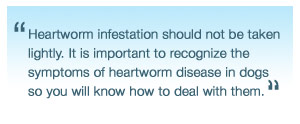 Heartworm infestation should not be taken lightly. It is important to recognize the symptoms of heartworm disease in dogs so you will know how to deal with them. Arming yourself with knowledge of this disease will put you in a better position to combat it. The good news is that you don’t have to fight heartworms alone. These days, with products like Heartgard and Revolution, heartworms can now be prevented. Surely, you don’t want your pet to suffer from these parasites, do you?
Heartworm infestation should not be taken lightly. It is important to recognize the symptoms of heartworm disease in dogs so you will know how to deal with them. Arming yourself with knowledge of this disease will put you in a better position to combat it. The good news is that you don’t have to fight heartworms alone. These days, with products like Heartgard and Revolution, heartworms can now be prevented. Surely, you don’t want your pet to suffer from these parasites, do you?
June 10, 2008
Be Informed: Canine Heartworm Guidelines by the American Heartworm Society

You have probably heard and read a lot about heartworms in dogs before-from pet magazines, on TV, from your closest friends, from fellow pet owners and other sources. But do you know what the experts say about heartworms?
To give you a clear idea about heartworms, the American Heartworm Society (AHS), a global organization involved in heartworm research, has set detailed guidelines for the diagnosis, prevention and management of heartworm disease in dogs. The AHS Guidelines are available in the group’s website, but to make them simpler to understand, here is a low-down of the most important points:
- Test pets for heartworm infection every year.
All dogs should be tested for heartworm infection annually. Part of this testing involves the assessment of the pet’s health before beginning any heartworm prevention program.
For pets already taking heartworm preventive medication (also known as preventive), annual testing monitors if the prescribed preventive still works for the pet; if not, the vet can recommend a different one.
- Use preventives.
Dog owners need to give heartworm preventives to their pets. These medications can be given orally or topically. Veterinarians are the best persons to recommend which medication is appropriate for the pet.
- Do additional tests.
When switching prevention methods, it is necessary to do additional tests, as these check whether or not the pet has heartworm disease. If the dog is found to have heartworms, the vet will recommend a different set of medication for treatment.
- Implement year-round prevention.
The AHS also supports year-round prevention. Giving heartworm preventives monthly for a period of one year ensures full protection of the dog against heartworms. Depending on the medication used, it can also protect against other intestinal parasites. For instance, Advantage Multi, a topical medication, does not only prevent heartworms but also kills adult fleas and other intestinal parasites. Meanwhile, Heartgard, a tablet medication for heartworm prevention, has no effect against other parasites.
These AHS guidelines have been created to inform the public about heartworm disease in dogs. These encourage veterinarians and pet owners to adopt standard procedures and ways to diagnose, prevent and manage the disease.
If you want to protect your pet’s health, be informed about heartworm disease because a clear understanding of it can help you make good decisions toward prevention and control.
Now that you know what the experts say about heartworms, don’t you feel that you now know how to prevent these parasites from infecting your dogs?
« Previous Page — Next Page »